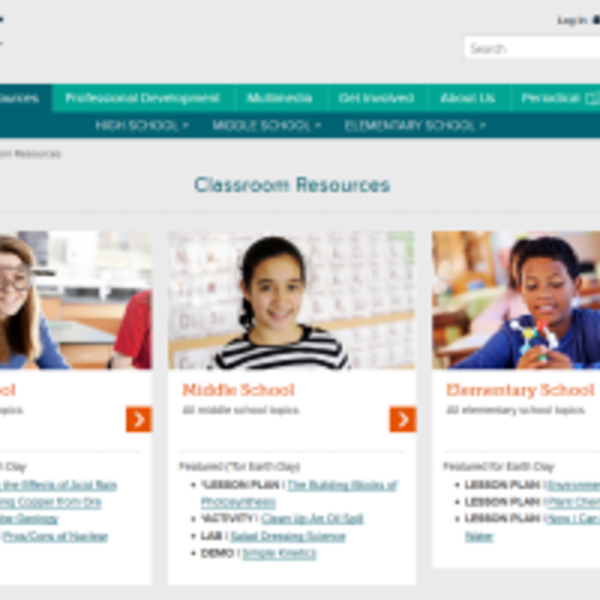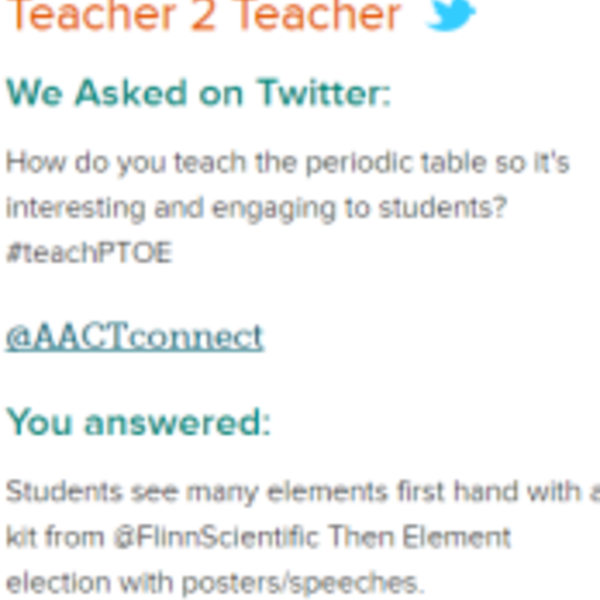Chemistry Solutions
It’s hard to believe the last issue of the first volume of Chemistry Solutions is here. I know what you’re thinking: What am I going to do without a new issue until September? The good news is that the back issues are always available, so you can read articles you missed when you were busy during the school year!

Including this issue, Chemistry Solutions has published 34 articles on topics ranging from chemistry in the elementary school classroom to pedagogically sound demos to scope and sequence of a chemistry curriculum to how powerful choice can be for student learning. We’ve had students share ideas, current teachers explain how they’ve developed some of their favorite resources, and retired teachers share their wisdom. Because of these articles, we’ve added more than 20 lessons to the AACT resource library.
 One goal of AACT is to help alleviate the feeling of isolation among teachers of chemistry. Having dedicated teachers share their ideas with the community by writing articles is one way AACT is achieving this goal. You may learn something from an article, but by leaving a comment you may spark a conversation that provides even more learning opportunities and collaboration within the community.
One goal of AACT is to help alleviate the feeling of isolation among teachers of chemistry. Having dedicated teachers share their ideas with the community by writing articles is one way AACT is achieving this goal. You may learn something from an article, but by leaving a comment you may spark a conversation that provides even more learning opportunities and collaboration within the community.
In this issue, some authors have specifically asked for readers to engage in conversation. Jenny Bishoff writes about how to easily clean up a disastrous prep room. She shares her experience, and she wants you to chime in with yours. Wanda Battaglia shares how Twitter and blogging have helped her become a better teacher. What social media do you engage in professionally? Pat Cunningham’s students debate nomenclature of a reaction type. Have you considered the vocabulary you use with your students? Cece Schwennsen and Michael Mury debrief the NGSS webinar they hosted. Share your questions or wisdom about NGSS.
Chemistry Solutions is a unique publication because it exists only in the digital realm. To fully embrace our digital existence, we link articles to resources, webinars, and blog entries. Additionally, in each issue we create and share with the AACT community a simulation that you can use with your students. We write a lesson around the simulation, but we encourage you to share any resources you’ve developed around our offerings, or that you want to share with the community. A long-term goal is to develop activities around the various video series we have in the multimedia library.
 Another opportunity to engage teachers in a digital conversation is through the “Teacher 2 Teacher” (T2T) column in each issue of Chemistry Solutions. You may have noticed that we occasionally ask questions on social media (Twitter, Facebook). We compile your answers and share a few with readers. Some questions we’ve used for T2T have been submitted by teachers, and some are to help us offer our members programs they want. Do you have a question you’d like to see featured in T2T? Email me with your suggestions at AACTeditor@acs.org.
Another opportunity to engage teachers in a digital conversation is through the “Teacher 2 Teacher” (T2T) column in each issue of Chemistry Solutions. You may have noticed that we occasionally ask questions on social media (Twitter, Facebook). We compile your answers and share a few with readers. Some questions we’ve used for T2T have been submitted by teachers, and some are to help us offer our members programs they want. Do you have a question you’d like to see featured in T2T? Email me with your suggestions at AACTeditor@acs.org.
The AACT team is so grateful for our charter members. You’ve helped us create and grow this community of passionate teachers and learners to more than 2,100 since we launched in August. We encourage you to keep participating and to consider playing an even more active role. Start small. Leave a comment. Eventually you may find yourself sharing your ideas in a more formal capacity by writing a Chemistry Solutions article (submit an article here). However you want to be involved, we’re happy to have you. Fill out our Get Involved form to tell us how you want to be a more active community member.
I know there are still a few weeks left in the school year, but enjoy the well-deserved summer break. And I hope you are already looking forward to what Volume 2 of Chemistry Solutions has to bring. I know I am!
Emily Bones
Chemistry Solutions editor